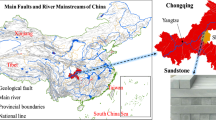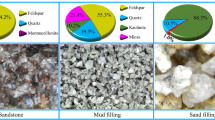Abstract
Unconventional oil and gas reservoirs are normally characterized by low porosity and low permeability and need to be hydraulically fractured to produce fracture networks and achieve the potential for economic production. Reservoir rocks are generally characterized by bedding planes, which have a significant impact on fracture propagation. In this study, a double torsion experiment was used to simulate tensile fracture propagation during hydraulic fracturing. The effect of bedding planes on fracture toughness, fracture morphology, and propagation rate in shale and tight sandstone was studied. Micromechanical mechanisms were analyzed through a microindentation experiment. The results show that as the angle between bedding and a pre-cut plane increases, fracture toughness first decreases and then increases, while the subcritical fracture propagation rate first increases and then decreases. The inflection point for this behavior occurs at an angle of 30° between the bedding and pre-cut plane. The shape of the tensile fractures is mainly influenced by the micromechanical properties of the adjacent bedding plane. When the ratio of elastic modulus between adjacent beds is 0.67, fractures propagate along the bedding plane, while at a ratio of 0.79, fractures extend through the bedding plane. These findings indicate that the angle between bedding and artificial planes as well as the difference in micromechanical properties of adjacent bedding planes are important to judge whether hydraulic fractures can penetrate or spread along a bedding plane.
Highlights
-
As the angle between bedding and a pre-cut plane increases, fracture toughness first decreases and then increases, while the subcritical fracture propagation rate first increases and then decreases.
-
The shape of the tensile fractures is mainly influenced by the micromechanical properties of the adjacent bedding plane.
-
When the ratio of elastic modulus between adjacent beds is 0.67, fractures propagate along the bedding plane, while at a ratio of 0.79, fractures extend through the bedding plane.
















Similar content being viewed by others
References
Blanton TL (1982) An experimental study of interaction between hydraulically induced and pre-existing fractures. In: SPE unconventional gas recovery symposium, OnePetro
Blanton TL (1986) Propagation of hydraulically and dynamically induced fractures in naturally fractured reservoirs. In: Spe Unconventional Gas Technology Symposium
Clark JA (1981) Hydraulic fracture propagation in layered rock: experimental studies of fracture containment. Soc Pet Eng J 24(1):19–32
Dan DQ, Konietzky H, Herbst M (2013) Brazilian tensile strength tests on some anisotropic rocks. Int J Rock Mech Min Sci 58:1–7. https://doi.org/10.1016/j.ijrmms.2012.08.010
Dandan H, Matzar L, Martysevich V (2014) Effect of natural fractures on eagle ford shale mechanical properties. Soc Pet Eng. https://doi.org/10.2118/170651-MS
Duan K, Kwok CY (2015) Discrete element modeling of anisotropic rock under Brazilian test conditions. Int J Rock Mech Min Sci 78:46–56. https://doi.org/10.1016/j.ijrmms.2015.04.023
Duan K, Kwok CY, Pierce M (2016) Discrete element method modeling of inherently anisotropic rocks under uniaxial compression loading. Int J Numer Anal Meth Geomech 40:1150–1183. https://doi.org/10.1002/nag.2476
Fengshou Z, Mengke An, Lianyang Z et al (2020) Effect of mineralogy on friction-dilation relationships for simulated faults: implications for permeability evolution in caprock faults. Geosci Front 11(02):79–90
Gale JFW, Reed RM, Holder J (2007) Natural fractures in the Barnett Shale and their importance for hydraulic fracture treatments. AAPG Bull 91:603–622. https://doi.org/10.1306/11010606061
Hu S-C, Tan Y-I, Zhou H, Guo W-Y, Hu D-W, Meng F-Z, Liu Z-G (2017) Impact of bedding planes on mechanical properties of sandstone. Rock Mech Rock Eng 50:2243–2251. https://doi.org/10.1007/s00603-017-1239-6
Hu T et al (2018) Geochemical and geological characteristics of Permian Lucaogou Formation shale of the well Ji174, Jimusar Sag, Junggar Basin, China: implications for shale oil exploration. Geol J 53:2371–2385. https://doi.org/10.1002/gj.3073
Jarvie DM, Hill RJ, Ruble TE, Pollastro RM (2007) Unconventional shale-gas systems: the Mississippian Barnett Shale of north-central Texas as one model for thermogenic shale-gas assessment. AAPG Bull 91:475–499. https://doi.org/10.1306/12190606068
Jian Z, Chen M, Yan J, Zhang GQ, Sciences M (2008) Analysis of fracture propagation behavior and fracture geometry using a tri-axial fracturing system in naturally fractured reservoirs. Int J Rock Mech Min Sci 45:1143–1152
Jz A, Yl B, Yp B, Xw C, My A, Xs D et al (2020) Experiments and analysis on the influence of multiple closed cemented natural fractures on hydraulic fracture propagation in a tight sandstone reservoir: sciencedirect. Eng Geol. https://doi.org/10.1016/j.enggeo.2020.105981
Kim K, Rutqvist J, Nakagawa S, Birkholzer J (2017) TOUGH-RBSN simulator for hydraulic fracture propagation within fractured media: model validations against laboratory experiments. Comput Geosci 108:72–85
King GE (2010) Thirty years of gas shale fracturing: what have we learned? Soc Pet Eng. https://doi.org/10.2118/133456-MS
Li YW, Zhang J, Liu Y (2016) Effects of loading direction on failure load test results for Brazilian tests on coal rock. Rock Mech Rock Eng 49(6):2173–2180
Liu X et al (2017) Pore-scale characterization of tight sandstone in Yanchang formation Ordos Basin China using micro-CT and SEM imaging from nm- to cm-scale. Fuel 209:254–264. https://doi.org/10.1016/j.fuel.2017.07.068
Mckinney KR, Smith HL (1973) Method of studying subcritical cracking of opaque materials. J Am Ceram Soc 56(1):30–32
Mighani S, Sondergeld CH, Rai CS (2016) Observations of tensile fracturing of anisotropic rocks. SPE J. https://doi.org/10.2118/2014-1934272-PA
Mousavi Nezhad M, Fisher QJ, Gironacci E, Rezania M (2018) Experimental study and numerical modeling of fracture propagation in shale rocks during brazilian disk test. Rock Mech Rock Eng 51:1755–1775. https://doi.org/10.1007/s00603-018-1429-x
Oliver WC, Pharr GM (1992) An improved technique for determining hardness and elastic modulus using load and displacement sensing indentation experiments. J Mater Res 7(6):1564–1583
Outwater JO, Gerry DJ (1968) On the fracture energy of glass. Phil Mag 18(156):1269–1280
Pan L, Dai F, Li G, Liu S (2015) A TGA/DTA-MS investigation to the influence of process conditions on the pyrolysis of Jimsar oil shale. Energy 86:749–757. https://doi.org/10.1016/j.energy.2015.04.081
Pang H, Pang X-q, Dong L, Zhao X (2018) Factors impacting on oil retention in lacustrine shale: Permian Lucaogou formation in Jimusaer depression, Junggar Basin. J Pet Sci Eng 163:79–90. https://doi.org/10.1016/j.petrol.2017.12.080
Shen B, Siren T, Rinne M (2014) Modelling fracture propagation in anisotropic rock mass. Rock Mech Rock Eng 48:1067–1081. https://doi.org/10.1007/s00603-014-0621-x
Tan X, Konietzky H, Frühwirt T, Dan DQ (2014) Brazilian tests on transversely isotropic rocks: laboratory testing and numerical simulations. Rock Mech Rock Eng 48(4):1341–1351
Tavallali A, Vervoort A (2010a) Effect of layer orientation on the failure of layered sandstone under Brazilian test conditions. Int J Rock Mech Min Sci 47:313–322. https://doi.org/10.1016/j.ijrmms.2010.01.001
Tavallali A, Vervoort A (2010b) Failure of layered sandstone under Brazilian test conditions: effect of micro-scale parameters on macro-scale behaviour. Rock Mech Rock Eng 43:641–653. https://doi.org/10.1007/s00603-010-0084-7
Tiennot M, Mertz JD, Bourgès A (2017) Influence of anisotropic microcracking due to swelling on the fracture toughness of a clay-bearing sandstone. Rock Mech Rock Eng 50:2861–2870. https://doi.org/10.1007/s00603-017-1273-4
Tiennot M, Mertz JD, Bourgès A (2019) Influence of clay minerals nature on the hydromechanical and fracture behaviour of stones. Rock Mech Rock Eng 52:1599–1611. https://doi.org/10.1007/s00603-018-1672-1
Wang Y, Li X, Zhang YX, Wu YS, Zheng B (2016) Gas shale hydraulic fracturing: a numerical investigation of the fracturing network evolution in the Silurian Longmaxi formation in the southeast of Sichuan Basin, China, using a coupled FSD approach. Environ Earth Sci 75:1093
Williams DP, Evans AG, JJOT and Evaluation (1973) A simple method for studying slow crack growth. TEST 1(4):264–270
Wu PF, Liang WG, Li ZG, Cao MT, Yang JF (2016a) Investigations on mechanical properties and crack propagation characteristics of coal and sandy mudstone using three experimental methods. Rock Mech Rock Eng 50:215–223. https://doi.org/10.1007/s00603-016-1048-3
Wu Y, Li X, He J, Zheng B (2016b) Mechanical properties of longmaxi black organic-rich shale samples from south China under uniaxial and triaxial compression states. Energies 9:1088. https://doi.org/10.3390/en9121088
Zc A, Yl A, Yp A, Bo LB, Ying SB, Jw B, Wei LB (2021) Study on CO 2 foam fracturing model and fracture propagation simulation. Energy. https://doi.org/10.1016/j.energy.2021.121778
Zhang Z, Li X (2016) Numerical Study on the Formation of Shear Fracture Network. Energies 9(4):299
Zhang J, Li XX, Li Y, Tao FY, Yan M (2021) Experimental research and numerical simulation: strength and rupture patterns of coal under Brazilian tensile test. Int J Oil Gas Coal Technol 21(2):225–244
Zhang Z, Xiao L (2016) The shear mechanisms of natural fractures during the hydraulic stimulation of shale gas reservoirs. Materials (Basel) 9:713
Acknowledgements
We would like to express our gratitude to Yueteng Wei for his help with the microindentation test. This work was financially supported by the Xinjiang conglomerate reservoir laboratory open project (Grant No. 2019D04008) and the Strategic Cooperation Technology Projects of CNPC and CUPB (Grant No. ZLZX2020-01).
Author information
Authors and Affiliations
Corresponding author
Ethics declarations
Conflict of Interest
We declare that we do not have any commercial or associative interest that represents a conflict of interest in connection with the work submitted.
Additional information
Publisher's Note
Springer Nature remains neutral with regard to jurisdictional claims in published maps and institutional affiliations.
Rights and permissions
About this article
Cite this article
Zhou, W., Shi, G., Wang, J. et al. The Influence of Bedding Planes on Tensile Fracture Propagation in Shale and Tight Sandstone. Rock Mech Rock Eng 55, 1111–1124 (2022). https://doi.org/10.1007/s00603-021-02742-2
Received:
Accepted:
Published:
Issue Date:
DOI: https://doi.org/10.1007/s00603-021-02742-2




